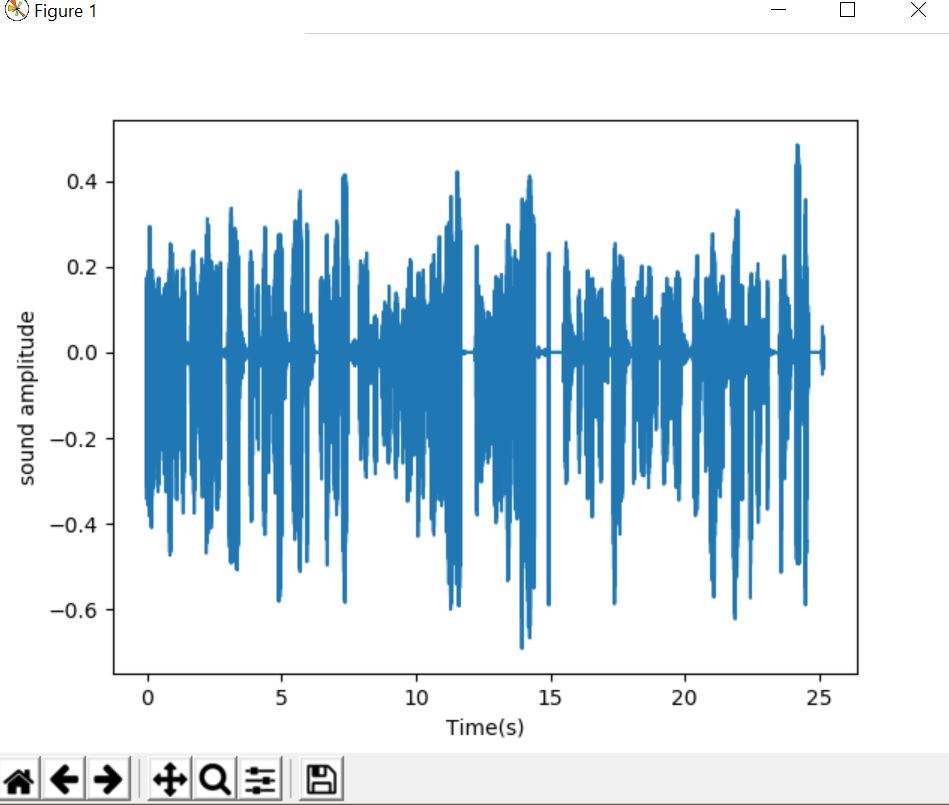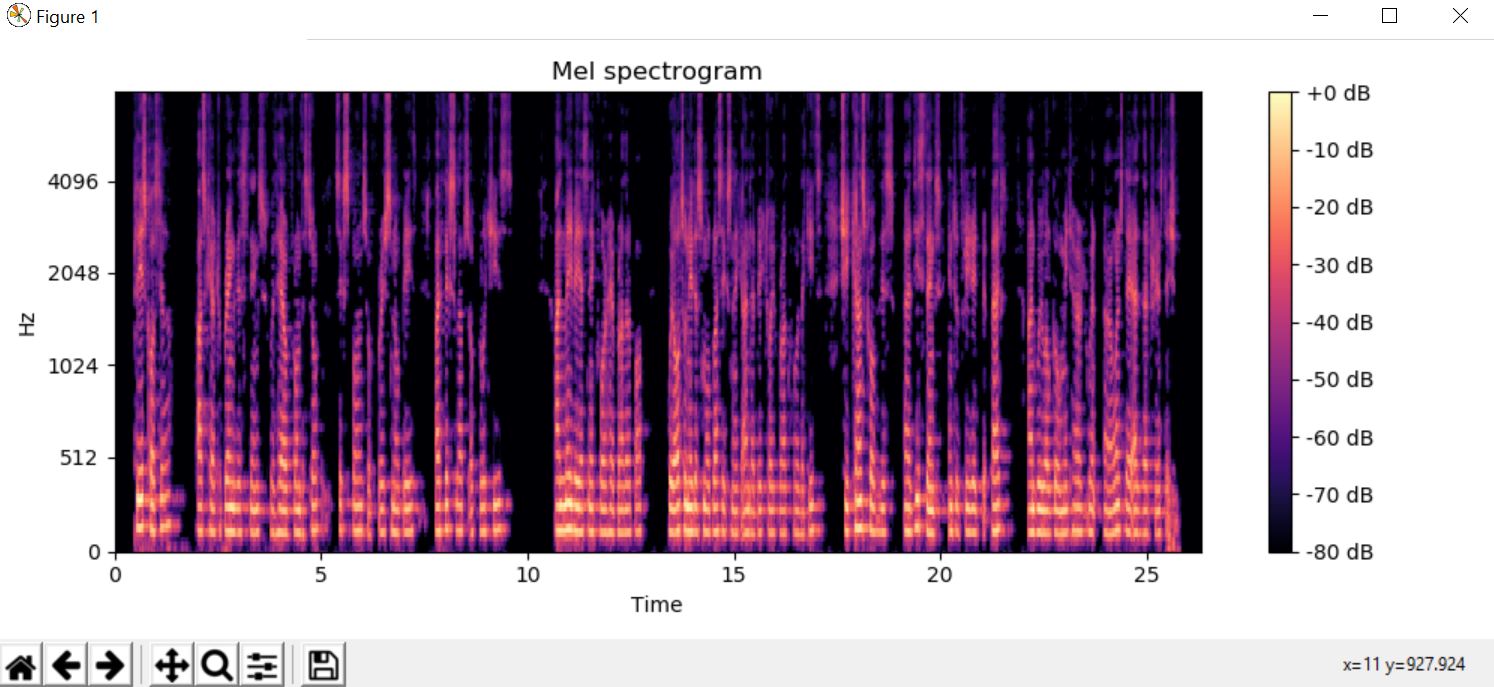
Open-Source Internship opportunity by OpenGenus for programmers. Apply now.
Reading time: 35 minutes | Coding time: 20 minutes
Librosa is powerful Python library built to work with audio and perform analysis on it. It is the starting point towards working with audio data at scale for a wide range of applications such as detecting voice from a person to finding personal characteristics from an audio.
In this article, we will learn:
- how to use Librosa and load an audio file into it
- Get audio timeline, plot it for amplitude, find tempo and pitch
- Compute mel-scaled spectrogram, time stretch an audio, remix an audio
It help us to implement:
- Audio signal analysis for music.
- Reference implementation of common methods.
- Building blocks for Music information retrieval (MIR).
For a better understanding of libROSA it is said to have a knowledge about NumPy and SciPy.
libROSA can be defined as a package which is structured as collection of submodules which further contains other functions.
For installing the libROSA you just need to run the following command in your command line:
pip install libROSA --user
In your Python code, you can import it as:
import librosa as lr
We will use Matplotlib library for plotting the results and Numpy library to handle the data as array.
Loading your audio file :
The first step towards our analysis is to load an audio library into our code. This is done using librosa.core.load() function. Audio will be automatically resampled to the given rate (default = 22050). To preserve the native sampling rate of the file, use sr=None.
librosa.core.load(path, sr=22050, mono=True, offset=0.0, duration=None, dtype=<class 'numpy.float32'>, res_type='kaiser_best')
where
- path: is the path to the audio file and is a string parameter
Any codec supported by soundfile or audioread will work. If the codec is supported by soundfile, then path can also be an open file descriptor (int), or any object implementing Python’s file interface. If the codec is not supported by soundfile (e.g., MP3), then only string file paths are supported.
-
sr is the sampling rate
-
mono is the option (true/ false) to convert it into mono file.
-
offset is a floating point number which is the starting time to read the file
-
duration is a floating point number which signifies how much of the file to load.
-
dtype is the numeric representation of data can be float32, float16, int8 and others.
-
res_type is the type of resampling (one option is kaiser_best)
Timeline for your audio
In this code, we will print the timeline of the audio file. We will simply load the audio, convert it into a numpy array and print the output for one sample (by dividing by sampling rate).
import numpy as np
import matplotlib.pyplot as plt
from glob import glob
import librosa as lr
audio='arabic6' # change with the name of your audio
y, sr = lr.load('./{}.wav'.format(audio)) #you just need to make sure your audio is in the same folder in which you are coding or else you can change the path as per your requirement
time = np.arange(0,len(y))/sr
print(time) # prints timeline of arabic6
Output :
[0.00000000e+00 4.53514739e-05 9.07029478e-05 ... 2.63027211e+01
2.63027664e+01 2.63028118e+01]
Plotting the audio :
Plotting the audio as Time v/s Sound amplitude
import numpy as np
import matplotlib.pyplot as plt
from glob import glob
import librosa as lr
audio='arabic6'
y, sr = lr.load('./{}.wav'.format(audio))
time = np.arange(0,len(y))/sr
fig, ax = plt.subplots()
ax.plot(time,y)
ax.set(xlabel='Time(s)',ylabel='sound amplitude')
plt.show()
Output :
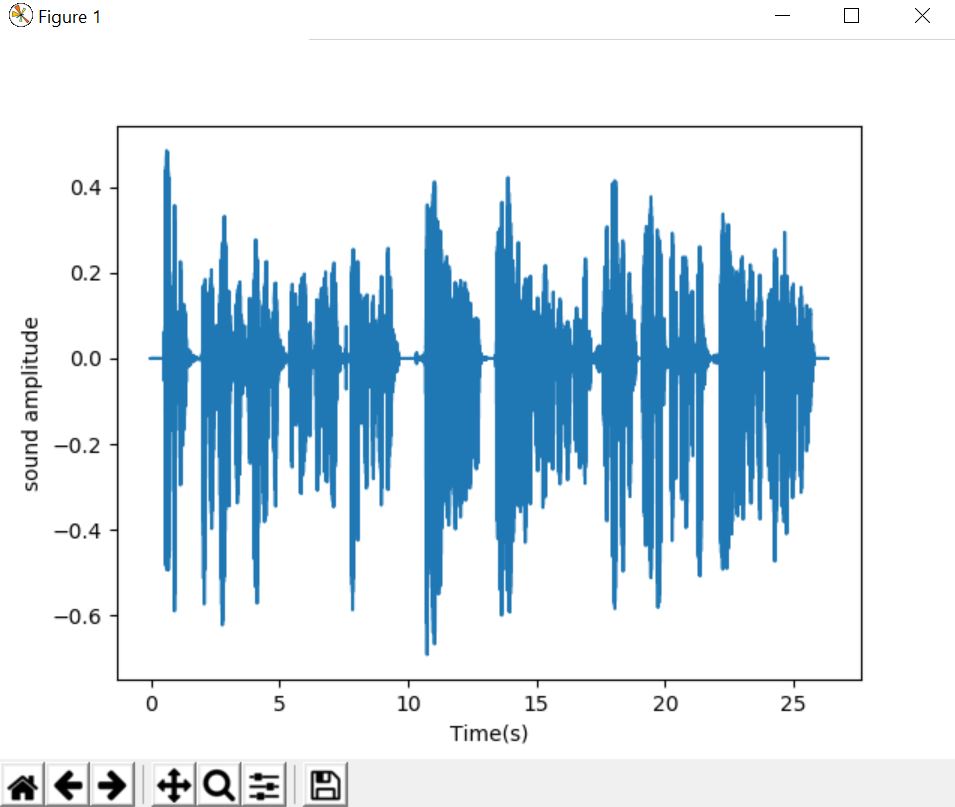
Plotting and finding the estimating tempo
Tempo was originally used to describe the timing of music, or the speed at which a piece of music is played or can be defined as beats per second.
librosa.beat.tempo(y=None, sr=22050, onset_envelope=None, hop_length=512, start_bpm=120, std_bpm=1.0, ac_size=8.0, max_tempo=320.0, aggregate=<function mean at 0x7f3faa08a510>)
It will return tempo as an array
Parameters:
- y: audio time series
- sr: sampling rate of the time series
- onset_envelope: pre-computed onset strength envelope
- hop_length: hop length of the time series
- start_bpm: initial guess of the BPM
- std_bpm: standard deviation of tempo distribution
- ac_size: length (in seconds) of the auto-correlation window
- max_tempo: estimate tempo below this threshold
- aggregate: for estimating global tempo. If None, then tempo is estimated independently for each frame.
CODE
import numpy as np
import matplotlib.pyplot as plt
from glob import glob
import librosa as lr
audio='arabic6'
y, sr = lr.load('./{}.wav'.format(audio))
onset_env = lr.onset.onset_strength(y, sr=sr)
tempo = lr.beat.tempo(onset_envelope=onset_env, sr=sr)
print(tempo)
tempo = np.asscalar(tempo)
# Compute 2-second windowed autocorrelation
hop_length = 512
ac = lr.autocorrelate(onset_env, 2 * sr // hop_length)
freqs = lr.tempo_frequencies(len(ac), sr=sr,hop_length=hop_length)
# Plot on a BPM axis. We skip the first (0-lag) bin.
plt.figure(figsize=(8,4))
plt.semilogx(freqs[1:], lr.util.normalize(ac)[1:],label='Onset autocorrelation', basex=2)
plt.axvline(tempo, 0, 1, color='r', alpha=0.75, linestyle='--',label='Tempo: {:.2f} BPM'.format(tempo))
plt.xlabel('Tempo (BPM)')
plt.grid()
plt.title('Static tempo estimation')
plt.legend(frameon=True)
plt.axis('tight')
plt.show()
Output :
[112.34714674]
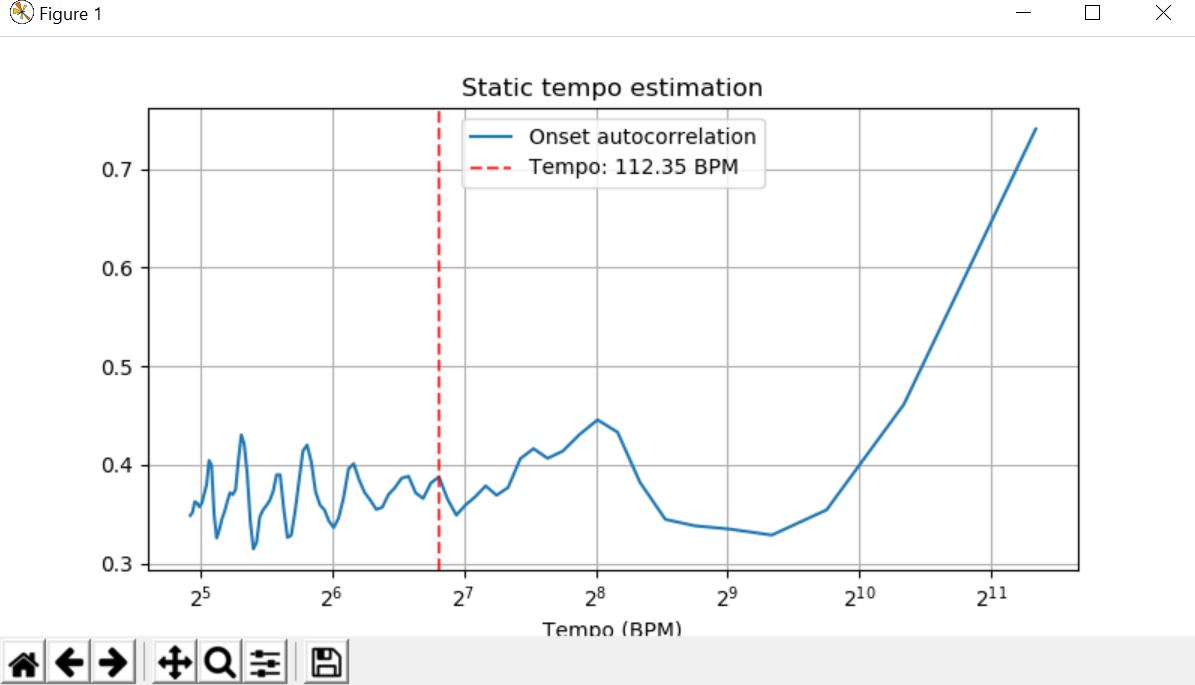
Finding and plotting the pitch
The sensation of a frequency is commonly referred to as the pitch of a sound. A high pitch sound corresponds to a high frequency sound wave and a low pitch sound corresponds to a low frequency sound wave.
librosa.core.piptrack(y=None, sr=22050, S=None, n_fft=2048, hop_length=None, fmin=150.0, fmax=4000.0, threshold=0.1, win_length=None, window='hann', center=True, pad_mode='reflect', ref=None)
Paramters :
-
y: audio signal
-
sr: audio sampling rate of y
-
S: magnitude or power spectrogram
-
n_fft: number of FFT bins to use, if y is provided.
-
hop_length: number of samples to hop
-
threshold: A bin in spectrum S is considered a pitch when it is greater than threshold * ref(S).
-
fmin: lower frequency cutoff.
-
fmax: upper frequency cutoff.
-
win_length: Each frame of audio is windowed by window().
-
ref:scalar or callable for pitch
It returns:
- pitches:np.ndarray [shape=(d, t)]
- magnitudes:np.ndarray [shape=(d,t)]
Where d is the subset of FFT bins within fmin and fmax.
pitches[f, t] contains instantaneous frequency at bin f, time t
magnitudes[f, t] contains the corresponding magnitudes.
Both pitches and magnitudes take value 0 at bins of non-maximal magnitude.
CODE
import numpy as np
import matplotlib.pyplot as plt
from glob import glob
import librosa as lr
from IPython.display import Audio
audio='arabic6'
y, sr = lr.load('./{}.wav'.format(audio))
pitches, magnitudes = lr.piptrack(y=y, sr=sr)
print(pitches)
print('///')
print(magnitudes)
plt.subplot(212)
plt.show()
plt.plot(pitches)
plt.show()
Output :
[[0. 0. 0. ... 0. 0. 0.]
[0. 0. 0. ... 0. 0. 0.]
[0. 0. 0. ... 0. 0. 0.]
...
[0. 0. 0. ... 0. 0. 0.]
[0. 0. 0. ... 0. 0. 0.]
[0. 0. 0. ... 0. 0. 0.]]
///
[[0. 0. 0. ... 0. 0. 0.]
[0. 0. 0. ... 0. 0. 0.]
[0. 0. 0. ... 0. 0. 0.]
...
[0. 0. 0. ... 0. 0. 0.]
[0. 0. 0. ... 0. 0. 0.]
[0. 0. 0. ... 0. 0. 0.]]
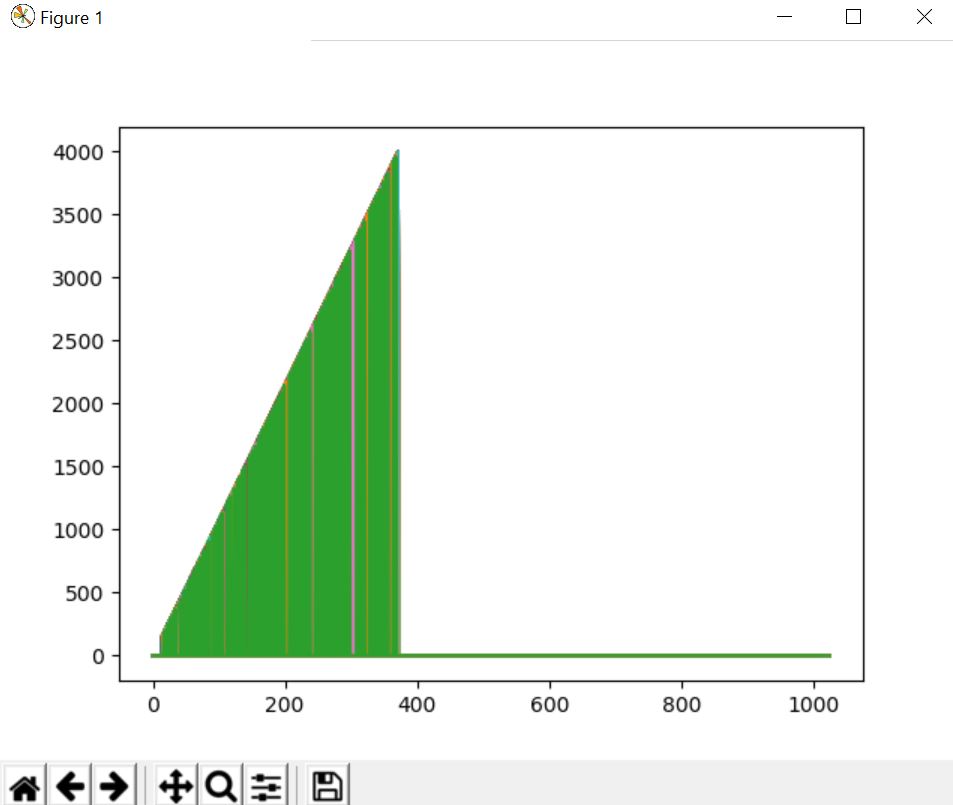
Compute a mel-scaled spectrogram
An object of type MelSpectrogram represents an acoustic time-frequency representation of a sound
librosa.feature.melspectrogram(y=None, sr=22050, S=None, n_fft=2048, hop_length=512, win_length=None, window='hann', center=True, pad_mode='reflect', power=2.0, **kwargs)
Parammeters :
-
y: audio time-series
-
sr: sampling rate of y
-
S: spectrogram
-
n_fft: length of the FFT window
-
hop_length: number of samples between successive frames. See librosa.core.stft
-
win_length: Each frame of audio is windowed by window().
-
power: Exponent for the magnitude melspectrogram. e.g., 1 for energy, 2 for power, etc.
-
kwargs:additional keyword arguments
Mel filter bank parameters. See librosa.filters.mel for details.
Returns:
- S:np.ndarray [shape=(n_mels, t)]
Mel spectrogram
CODE
import numpy as np
import matplotlib.pyplot as plt
from glob import glob
import librosa as lr
import librosa.display
audio='arabic6'
y, sr = lr.load('./{}.wav'.format(audio))
lr.feature.melspectrogram(y=y, sr=sr)
D = np.abs(lr.stft(y))**2
S = lr.feature.melspectrogram(S=D)
S = lr.feature.melspectrogram(y=y, sr=sr, n_mels=128,fmax=8000)
plt.figure(figsize=(10, 4))
lr.display.specshow(lr.power_to_db(S,ref=np.max),y_axis='mel', fmax=8000,x_axis='time')
plt.colorbar(format='%+2.0f dB')
plt.title('Mel spectrogram')
plt.tight_layout()
plt.show()
Output :
Modifying the audio :
Time-stretch an audio series by a fixed rate
librosa.effects.time_stretch(y, rate, **kwargs)
Parameters:
- y: audio time series
- rate: Stretch factor. If rate > 1, then the signal is sped up. If rate < 1, then the signal is slowed down.
- kwargs: additional keyword arguments.
See librosa.decompose.stft for details.
Returns:
- y_stretch: audio time series stretched by the specified rate
CODE
import numpy as np
import matplotlib.pyplot as plt
from glob import glob
import librosa as lr
audio='arabic6'
y, sr = lr.load('./{}.wav'.format(audio))
y_fast = lr.effects.time_stretch(y, 2.0)
time = np.arange(0,len(y_fast))/sr
fig, ax = plt.subplots()
ax.plot(time,y_fast)
ax.set(xlabel='Time(s)',ylabel='sound amplitude')
plt.show()#compress to be twice as fast
y_slow = lr.effects.time_stretch(y, 0.5)
time = np.arange(0,len(y_slow))/sr
fig, ax = plt.subplots()
ax.plot(time,y_slow)
ax.set(xlabel='Time(s)',ylabel='sound amplitude')
plt.show()#half the original speed
Output :
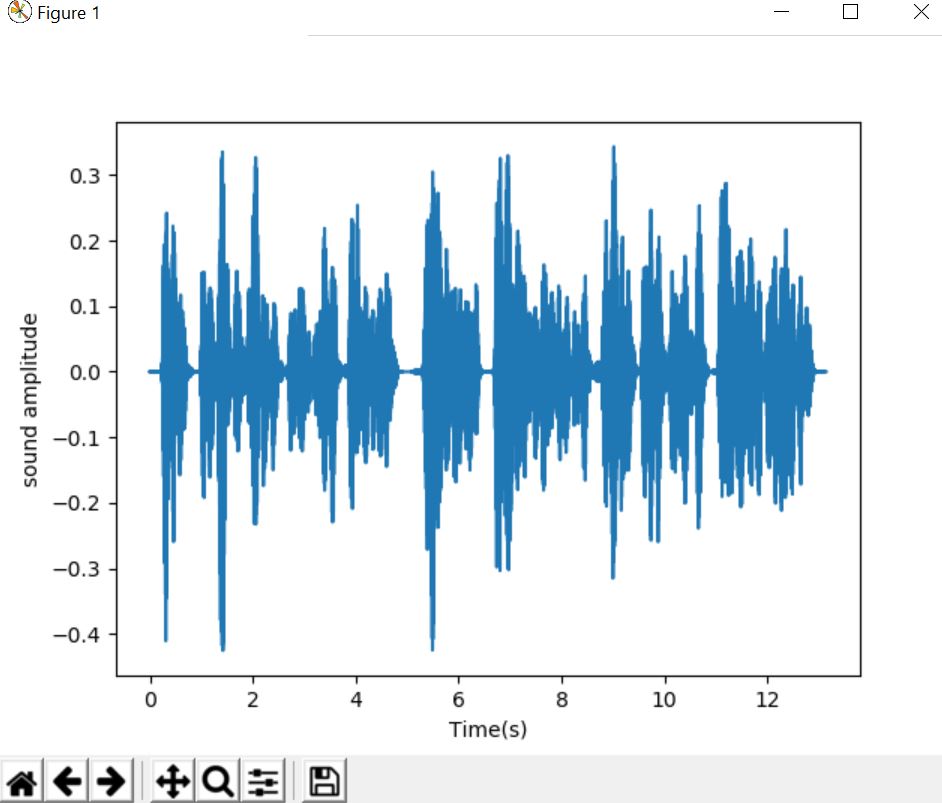
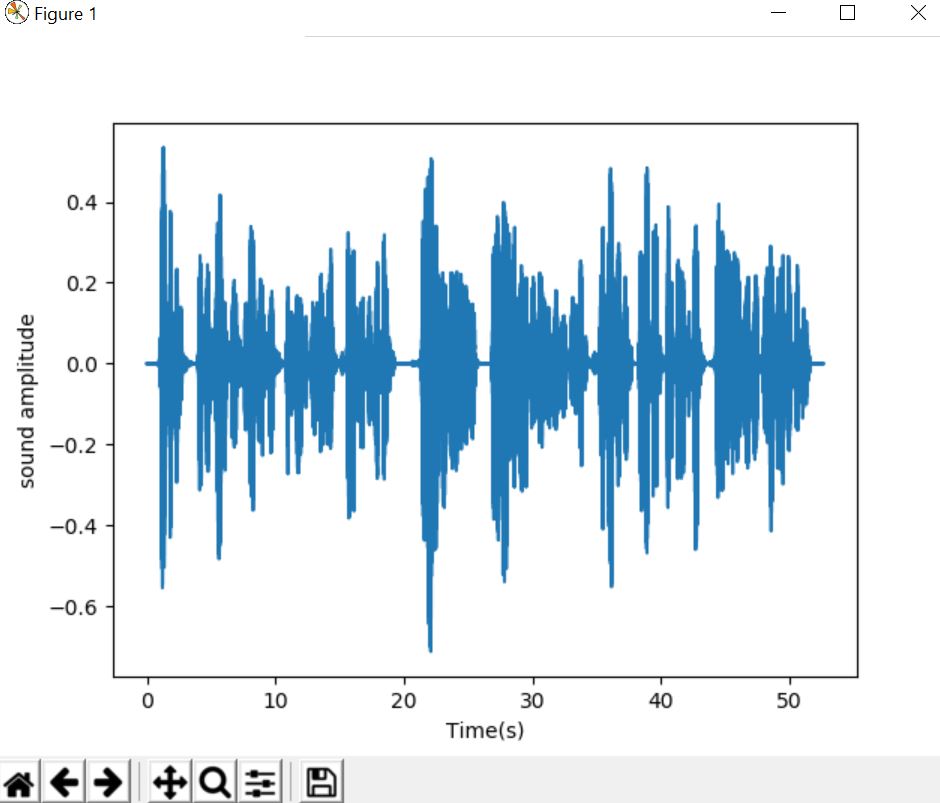
Remix an audio signal by re-ordering time intervals
Remix is a piece of media which has been altered from its original state by adding, removing and changing pieces of the item. A song, piece of artwork, books, video, or photograph can all be remixes. The only characteristic of a remix is that it appropriates and changes other materials to create something new.
librosa.effects.remix(y, intervals, align_zeros=True)
Parameters :
-
y: Audio time series
-
intervals: iterable of tuples (start, end)
An iterable (list-like or generator) where the ith itemintervals[i] indicates the start and end (in samples) of a slice of y. -
align_zeros: boolean
If True, interval boundaries are mapped to the closest zero-crossing in y. If y is stereo, zero-crossings are computed after converting to mono.
Returns:
- y_remix:np.ndarray [shape=(d,) or (2, d)]
- y remixed in the order specified by intervals
CODE
import numpy as np
import matplotlib.pyplot as plt
from glob import glob
import librosa as lr
audio='arabic6'
y, sr = lr.load('./{}.wav'.format(audio))
_, beat_frames = lr.beat.beat_track(y=y, sr=sr,hop_length=512)
beat_samples = lr.frames_to_samples(beat_frames)
intervals = lr.util.frame(beat_samples, frame_length=2,hop_length=1).T
y_out = lr.effects.remix(y, intervals[::-1])
time = np.arange(0,len(y_out))/sr
fig, ax = plt.subplots()
ax.plot(time,y_out)
ax.set(xlabel='Time(s)',ylabel='sound amplitude')
plt.show()
Output :
